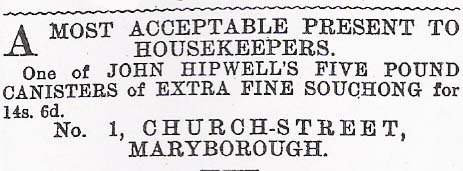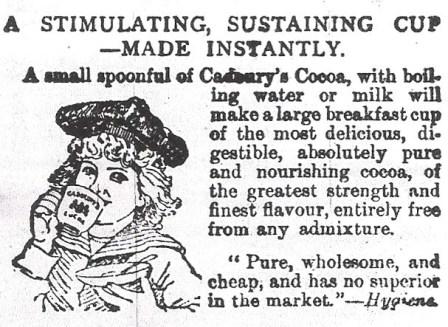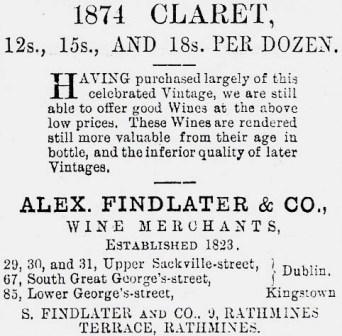
In Ireland in the 18th and 19th centuries, alcoholic beverages such as beer and wine were usually drunk with dinner, as clean, safe drinking water was not readily available. At large houses such as Emo Court, beer was usually homebrewed and was served to servants and labourers on the estate. The aristocracy, of course, drank wine alongside the staples of champagne, sherry and port. They also drank spirits such as whiskey and gin, which were sometimes flavoured with fruit from the estate. In a letter dated 1781, for example, Miss Herbert wrote of drinking large quantities of black cherry whiskey during her stay at Dawson's Court (the house which preceded Emo). Non-alcoholic beverages consumed at Emo included tea and hot chocolate, which were available only to the upper classes in the late 18th and early 19th centuries.
On hot summer days or when a ball was thrown, lighter more refreshing beverages were often consumed. Popular summer drinks for garden parties and balls included homemade lemonade, iced-tea, and alcoholic cocktails such as lemon flip (a lemon flavoured sherry drink), shandy gaff (a mixture of ale and ginger beer), and East India Punch (a punch containing brandy, port, lemon rind, lime syrup, seltzer water and sprigs of syringa).
Tea
 |
Tea was a popular beverage at large houses such as Emo Court, where it was traditionally enjoyed by ladies as part of the ritual of "afternoon tea". While the practice of tea drinking had been introduced to Ireland by the mid-17th century, it was not until the 1840s that Bewleys, the first tea blenders in Ireland, set up business here. Prior to this, tea was imported from merchants in London and was extremely expensive. As a result, precious tea leaves were locked away in tea caddies until needed, and strict accounts were kept of when new batches of tea leaves were purchased and opened. |
|
Advertisement
for Tea Leinster Express, Dec 16th, 1876
|
An entry in the journal of the 2nd Earl of Portarlington, dated Dec 20th 1817, for example, notes that he began 2 lbs of black and 2 lb of green tea on that day.
At first, tea leaves were so expensive that they were reused twice. By the mid-18th century, however, the practice of tea drinking was beginning to percolate even to the ranks of labourers, and it was to become a popular beverage with both Lord and labourer alike.
Hot chocolate
 |
Chocolate had been introduced to Ireland in the late 18th century, when it came in a cake or roll and had to be grated into hot liquid. At first it was mixed with wine rather than hot water. Cocoa wine was still sold in Irish chemists in the late 19th century, with brands like Larochelle's marketed as a medicinal cure and "special stimulant of the nervous system". The recommended dose of this stimulating liquid was a half- to one wine-glassful three or four times a day. Hot chocolate made simply with boiling milk or water was to become a popular breakfast and bedtime drink among the Victorian aristocracy. By the late 19th century, it was widely available in powdered form, with Cadbury's a popular brand. |
|
Advertisement
for Hot Chocolate Leinster Express March 6th 1897
|
Wine
 |
While the servants at Emo drank beer with their meals, the Dawson-Damer family drank wine. In the Victorian period, a different wine was served with each dinner course. The traditional order for wines was as follows: Chablis or Sauterne with hors d'oeuvres; Sherry or Marsala with soup; Hock or Sauterne with fish; Claret or Burgundy with entrées; Champagne with roast and entremêts; Port, Claret or Madeira with dessert. The diary of the 2nd Earl contains many references to wine bought in bulk for the two wine cellars located below the portico of Emo. In March 1833, for example, a single delivery to the house included six dozen bottles of Cunningham's champagne and eleven dozen magnums of vintage (1827) claret. Wines which had been stored in the cellars for a long time were carefully decanted by the butler before presentation at the dinner table. |
|
Leinster
Express Sept 29th, 1878
|
Syllabub
Another traditional drink was syllabub. Syllabub was originally made by milking
a cow into a bowl of ale or cider, to give a frothy top to the drink. By the
17th century, milk and ale were replaced by cream and wine whipped together
with lemon rind, nutmeg and castor sugar. Thus, syllabub was transformed from
a drink to a whipped cream dessert. Mrs Beeton's recipe for whipped syllabub
involved placing it on a layer of macaroons and leaving the dish to stand for
12 hours before serving.